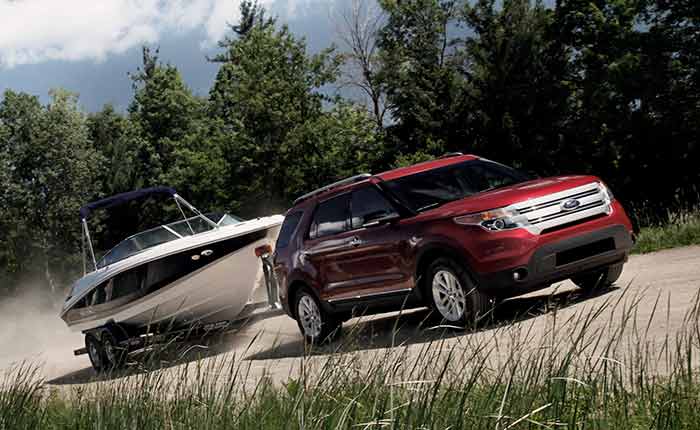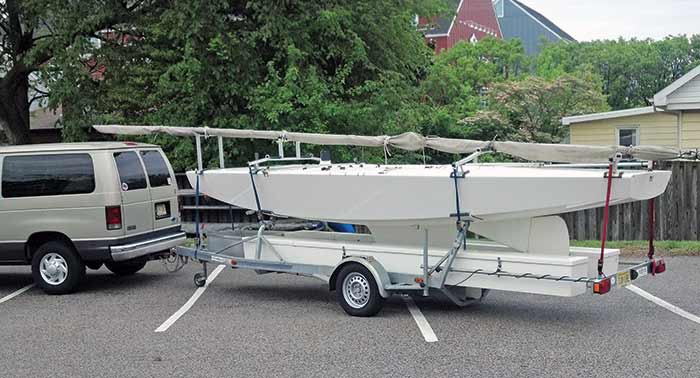Advertisement
Heading for the wide-open spaces with a boat in tow means leaving some space ... more than you would without the boat in tow.

Hitting the highway with a boat trailer that has been properly matched with and secured to the vehicle goes a long way toward assuring a trouble-free trip (see video checklist details). If you've double checked everything, and given the rig a "sea trial" run around the neighborhood and a leg on the highway at freeway speeds, you're clear to take to the road.
But there, you have additional responsibilities as you share the highway with fellow travelers. The extra weight, length, and axle or two combine to make your rig a bigger threat to other drivers, and it's important that you recognize your limitations when towing the family boat.
Spot The Difference
The first difference you may notice when towing a boat trailer is how much longer it takes you to accelerate when compared to driving the same vehicle without a load in tow. The added weight of the trailered boat makes the rig heavier and therefore harder to get up to speed. The weight factor also contributes to the second difference you will note when towing a trailer: how much harder it is to slow the rig or bring it to a stop.
Know Your Distance
Even if the trailer is equipped with surge or electric brakes, stopping distances will likely be far longer and you will need to factor in how far it takes to slow or stop your rig on-the-road.
That's why one of the most important considerations to keep in mind while towing a boat is that it will take you longer to accelerate and longer to come to a stop. That means giving yourself added space when accelerating to pull out into traffic or pass another vehicle, as well as added distance between your vehicle and one ahead of you when underway. When it comes time to slow for a turn, or stop for a traffic light, toll booth, or traffic, you need to have given yourself enough room ahead to do so without excessive, last-moment braking.

The Twists And Turns Of Trailering
Turning with a boat trailer in tow is different, too. Your extended two-piece rig will not corner as sharply as does the vehicle alone. Because your trailer’s wheels are drawn closer to the inside of a turn than the wheels of your tow vehicle during the maneuver, the trailer's tires will hit or ride up over curbs — or worse — unless you compensate for the extended load by taking the turn wider from the start. When approaching a turn, position your tow vehicle on the outside of the lane to allow the rig to execute a wide turn. Don't cut your steering wheel until your vehicle's rear wheels have passed the inside curb.
Passing also requires factoring-in the weight and length of your vehicle-and-trailer combo. It's going to take you much longer to get up to passing speed, and you'll require more space ahead of the vehicle you are passing to safely return to the cruising lane — and more distance to slow down if needed during the maneuver. My advice: Don't pass unless the car in front of you is really going that slow.
Weather Watch
Wind is another factor that influences a towing rig far more than a vehicle alone. Whether from an air wave created by a passing tractor trailer or a blow from Mother Nature, your rig's extended profile is larger and therefore affected more by any sudden shift in the wind. Large vehicles develop a wave of high-pressure air in front of them and a low-pressure area behind as they speed down the highway. When passed by a big truck on the left, first your trailer and then your tow vehicle may be pushed to the right by the vehicle's "bow wave." Once the truck passes, your rig may be sucked back to the left by the low-pressure zone that follows the vehicle. Unless you are ready for the sudden shifts, with both hands on the wheel and prepared to compensate by steering a bit left then a bit right during the passing process, it can be a startling event. If the wind is really howling, you should consider pulling over at the next rest stop and tucking your rig among those of veteran truckers doing the same until the weather moderates.
Keep the Rubber on the Road
The National Association of Trailer Manufacturers says boat trailer tires have a maximum speed rating of 62-68 mph, so keep this in mind when driving on interstates.
Road trial: Make sure the boat, trailer, and tow vehicle are loaded as close to the weight as they will be on your trip and that you get up to cruising speed on the highway to test for any tendencies to fishtail.
Braking: While underway in traffic, double the old "car length for every 10 mph of speed" advice you learned in driver's ed to maintain a safe braking distance ahead. Then be ready to get cut off by fellow drivers who see the void between you and the vehicle ahead.
Shift: Downshift to a lower gear instead of riding your brakes when going downhill for any distance to allow the engine to help keep your speed in check.
When Things Get Fishy
Once you've determined your tongue weight and distributed the weight of your boat and load properly, and given the rig a road test, fishtailing should not occur. However, sometimes a shift in the load, gust of wind, fast-passing truck, bump in the road, or slight but sudden jerk of the wheel or tap of the brake can cause the trailer to sway or "fishtail" from side to side. It's a frightening experience and the only way to remedy the problem is to slow down gradually while turning the wheel as little as possible. It can be tempting to brake in an effort to reduce speed, but that can make your troubles all the worse as will trying to compensate for the swaying by turning the wheel. So, foot off the brake and stay in your lane, and let the rig slow down.
You'll find when you reach a speed around 25-35 mph, the swaying will stop if this is a low-tongue-weight issue. Get to the side of the road and get to work getting more weight toward the front of the boat trailer. If you're in the passing lane, the key thing to do is let the rig slow down, so don't worry about all the horns that may be blowing behind you. Stay in your lane, get the trailer to stop swaying, move to the right lane and then to a safe place along the shoulder of the road.
